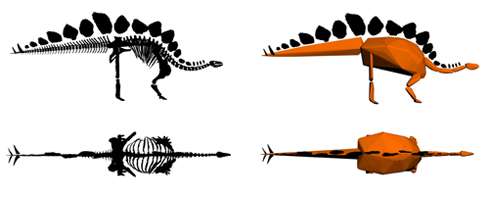March 4, 2015 report
Museum workers able to digitally recreate Stegosaurus to find its mass

(Phys.org)—A team of workers at Britain's Natural History Museum in London has used 3D scans of the bones of "Sophie" the most complete Stegosaurus skeleton ever found, to calculate the dinosaur's body mass at death. In their paper published in the journal Biology Letters, the team describes how they calculated the dinosaur's body mass two different ways and came up with nearly the same result, suggesting their calculations are likely accurate.
Despite their familiarity to people around, the world, not much is actually known about the Stegosaurus—the dino with plates on its back and spikes on its tail—very few skeletal remains have been found. Sophie's remains (which included 85 percent of its original bones) were discovered and unearthed in 2003 at Red Canyon Ranch in Wyoming and were subsequently purchased by NHM (with help from a large grant given by an unnamed donor, Sophie is the name of his daughter). Shortly after the remains arrived, the team scanned all of the bones with a 3D scanner and imported the results into a CAD package. That allowed them to add muscle, fat, and other body elements virtually and then to tally the total mass of the dinosaur at the time of its death—approximately 1,560kg, which is equivalent to a large modern cow or small rhino. Sophie is much smaller than other Stegosaurus's that have been found because "she" was much younger when she died. Nobody knows the gender but museum workers have taken to calling it a she because of the nickname it has been given.
Prior to using the 3D scanning approach, the researchers note, body mass for dinosaurs was calculated by measuring the femur and humerus and comparing the results to modern animals. The team did that with Sophie too, and came up with virtually the same body mass as with the CAD package, which has them confident that they have got it right.
Coming up with an accurate body mass allows researchers to learn more about other attributes or characteristics of the dinosaur, which lived approximately 150 million years ago—such as what did it eat, and how fast might it have been able to run. Sophie has been put back together and is now on display at the museum.
More information: — Body mass estimates of an exceptionally complete Stegosaurus (Ornithischia: Thyreophora): comparing volumetric and linear bivariate mass estimation methods, Biology Letters, Published 4 March 2015, DOI: 10.1098/rsbl.2014.0984
Abstract
Body mass is a key biological variable, but difficult to assess from fossils. Various techniques exist for estimating body mass from skeletal parameters, but few studies have compared outputs from different methods. Here, we apply several mass estimation methods to an exceptionally complete skeleton of the dinosaur Stegosaurus. Applying a volumetric convex-hulling technique to a digital model of Stegosaurus, we estimate a mass of 1560 kg (95% prediction interval 1082–2256 kg) for this individual. By contrast, bivariate equations based on limb dimensions predict values between 2355 and 3751 kg and require implausible amounts of soft tissue and/or high body densities. When corrected for ontogenetic scaling, however, volumetric and linear equations are brought into close agreement. Our results raise concerns regarding the application of predictive equations to extinct taxa with no living analogues in terms of overall morphology and highlight the sensitivity of bivariate predictive equations to the ontogenetic status of the specimen. We emphasize the significance of rare, complete fossil skeletons in validating widely applied mass estimation equations based on incomplete skeletal material and stress the importance of accurately determining specimen age prior to further analyses.
— www.nhm.ac.uk/discover/studyin … saurus-skeleton.html
Journal information: Biology Letters
© 2015 Tech Xplore




















